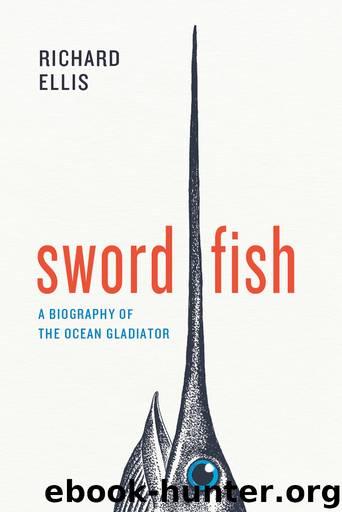Swordfish: A Biography of the Ocean Gladiator by Richard Ellis

Author:Richard Ellis [Ellis, Richard]
Language: eng
Format: epub
Publisher: University of Chicago Press
Published: 2013-11-17T05:00:00+00:00
Figure 6.4. Spearfish. Drawing by Richard Ellis.
The striped marlin is Tetrapturus audax; the spearfishes have been placed in the same genus. The International Game Fish Association recognizes two species, the longbill spearfish (Tetrapturus pfluegeri) and the shortbill (Tetrapturus angustirostris) but the FAO Billfish Species Catalog by Nakamura adds two more, the Mediterranean spearfish, T. belone, and the roundscale spearfish, T. georgii. All are about the same size—about six to seven feet long and 70–100 pounds in weight—and they resemble miniature marlins. They are differentiated by slightly different profiles and, in the case of the shortbill, a bill that barely overlaps the lower jaw. This abbreviated bill (again) raises questions of form and function. Such a stubby spear cannot possibly be used to stab prey, and it would be completely ineffective as a club. Why then would such an appendage have evolved? We might assume that the sharp snout functions as a cutwater that enables these slim, graceful creatures to race smoothly through the water, but asking “why” about animal morphology is often a futile exercise. Why, for example, do all other billfishes have pelvic fins while the swordfish has none?
The Mediterranean spearfish, T. belone, is the most common billfish in the central Mediterranean and completes its life cycle in this basin. It is characterized by a relatively short bill and a “forehead” that slopes backward from the bill in an almost straight line, as contrasted with the pronounced crest of other spearfish and marlins. Particularly abundant around Italy, this species probably swims in the upper 500 feet of water, generally above or within the thermocline. They travel in pairs, possibly feeding together; their diet consists mostly of fish. This spearfish is probably more widespread in the Mediterranean than was previously believed, as it is easy to confuse this species with the white marlin, T. albidus. Known as aguglia imperiale in Italian, this species is caught in gillnets, on longlines, by trollers, and by harpooners in the Straits of Messina. It reaches a maximum weight of 100 pounds and is considered a big-game fish. According to a recent report, this species “continues in increasing its importance in the market, in parallel with the increasing of its presence.”
Then there is Tetrapturus pfluegeri, the longbill spearfish, the smallest of the spearfishes, rarely exceeding 50 pounds in weight. Nakamura describes this species as “remarkably compressed, its depth very low. Bill slender and rather long, round in cross section; nape rather straight. . . .” Identified as a new species only in 1963 (Robins and de Sylva) T. pfluegeri is found throughout the North Atlantic south of Newfoundland and Spain, and in the South Atlantic from the mouth of the La Plata to western South Africa. The specific name pfluegeri comes from Al Pflueger, Sr., founder of Pflueger Taxidermy in Florida, perhaps the best known of game fish taxidermists. Angustirostris means narrow beak (from angustus, which is Latin for narrow, and rostrum, which, again, means beak, bill, or snout). The shortbill spearfish (Tetrapturus angustirostris), as befits its common and scientific names, has the shortest bill of any billfish.
Download
This site does not store any files on its server. We only index and link to content provided by other sites. Please contact the content providers to delete copyright contents if any and email us, we'll remove relevant links or contents immediately.
Sapiens: A Brief History of Humankind by Yuval Noah Harari(14166)
The Tidewater Tales by John Barth(12576)
Mastermind: How to Think Like Sherlock Holmes by Maria Konnikova(7164)
Do No Harm Stories of Life, Death and Brain Surgery by Henry Marsh(6840)
The Thirst by Nesbo Jo(6763)
Why We Sleep: Unlocking the Power of Sleep and Dreams by Matthew Walker(6557)
Life 3.0: Being Human in the Age of Artificial Intelligence by Tegmark Max(5405)
Sapiens by Yuval Noah Harari(5264)
The Longevity Diet by Valter Longo(4994)
The Body: A Guide for Occupants by Bill Bryson(4887)
The Rules Do Not Apply by Ariel Levy(4789)
The Immortal Life of Henrietta Lacks by Rebecca Skloot(4447)
Animal Frequency by Melissa Alvarez(4365)
Why We Sleep by Matthew Walker(4317)
The Hacking of the American Mind by Robert H. Lustig(4265)
Yoga Anatomy by Kaminoff Leslie(4248)
All Creatures Great and Small by James Herriot(4190)
Double Down (Diary of a Wimpy Kid Book 11) by Jeff Kinney(4145)
Barron's AP Biology by Goldberg M.S. Deborah T(4062)
